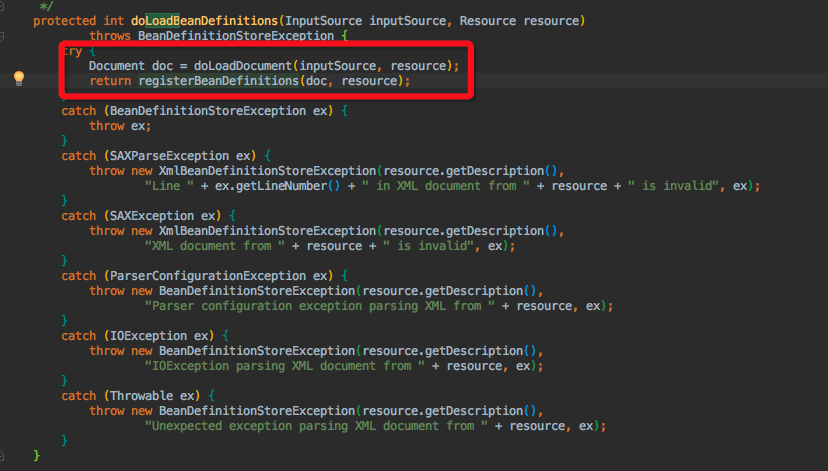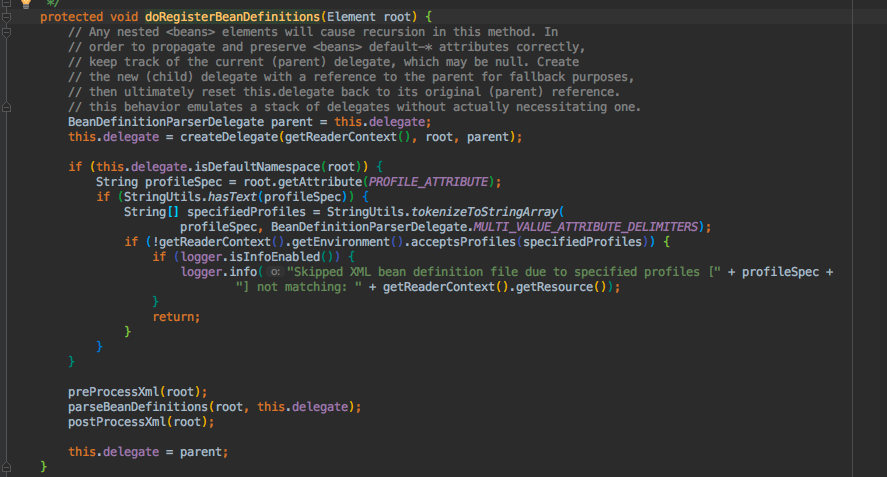spring ioc实现原理
1、一个普通的调用
ApplicationContext context = new ClassPathXmlApplicationContext("applicationContext.xml"); GsonFormatBean bean = (GsonFormatBean) context.getBean("GsonFormatBean"); bean.isPalindrome(100);
1.1 分析第一步

创建一个classPathXmlApplication的context,主要的实现在abstractAppplicationContext的refresh()这个方法中
@Override
public void refresh() throws BeansException, IllegalStateException {
synchronized (this.startupShutdownMonitor) {
// Prepare this context for refreshing.
prepareRefresh();
// Tell the subclass to refresh the internal bean factory.
ConfigurableListableBeanFactory beanFactory = obtainFreshBeanFactory();
// Prepare the bean factory for use in this context.
prepareBeanFactory(beanFactory);
try {
// Allows post-processing of the bean factory in context subclasses.
postProcessBeanFactory(beanFactory);
// Invoke factory processors registered as beans in the context.
invokeBeanFactoryPostProcessors(beanFactory);
// Register bean processors that intercept bean creation.
registerBeanPostProcessors(beanFactory);
// Initialize message source for this context.
initMessageSource();
// Initialize event multicaster for this context.
initApplicationEventMulticaster();
// Initialize other special beans in specific context subclasses.
onRefresh();
// Check for listener beans and register them.
registerListeners();
// Instantiate all remaining (non-lazy-init) singletons.
finishBeanFactoryInitialization(beanFactory);
// Last step: publish corresponding event.
finishRefresh();
}
catch (BeansException ex) {
if (logger.isWarnEnabled()) {
logger.warn("Exception encountered during context initialization - " +
"cancelling refresh attempt: " + ex);
}
// Destroy already created singletons to avoid dangling resources.
destroyBeans();
// Reset 'active' flag.
cancelRefresh(ex);
// Propagate exception to caller.
throw ex;
}
finally {
// Reset common introspection caches in Spring's core, since we
// might not ever need metadata for singleton beans anymore...
resetCommonCaches();
}
}
}
使用对象锁保证只有一个线程访问逻辑
第一步:

设置容器的一些全局性参数,比如closed,active等参数
第二步:

告诉父类创建一个bean工厂

刷新整个bean工厂,获取一个ConfigurableListableBeanFacotory,返回bean工厂。
刷新beanFactory

创建一个DefaultListableBeanFactory,设置一些属性,加载beanDefinition,具体的实现在abstractxmlApplicationContext、AnnotationWebConfigApplicationContext等
-------------------------------------------------------------------------------------------------------------------------------------------------------------------------------
容器怎么实现加载所有的bean

两个关键的方法:
容器注册所有的beanDefinitions

解析单个bean的操作

最终生成beanDefination,也就是将xml映射成为一个bean
------------------------------------------------------------------------------------------------------------------------------------------------------------------------------------------------------------------------